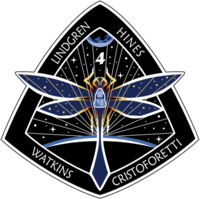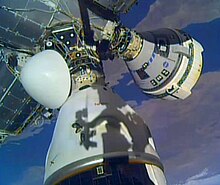cosmos.wikisort.org - Spacecraft
SpaceX Crew-4 was the Crew Dragon's fourth NASA Commercial Crew operational flight, and its seventh overall crewed orbital flight. The mission launched on 27 April 2022 at 07:52 UTC[5] before docking with the International Space Station (ISS) at 23:37 UTC. It followed shortly after the private Axiom 1 mission to the ISS earlier in the month utilizing SpaceX hardware. Three American (NASA) astronauts and one European (ESA) astronaut were onboard the mission.[6][7] [8]
 Crew Dragon Freedom launches to the ISS with the crew members of Crew-4 onboard. | |
| Names | USCV-4 |
|---|---|
| Mission type | ISS crew transport |
| Operator | SpaceX |
| COSPAR ID | 2022-042A |
| SATCAT no. | 52318 |
| Mission duration | 170 days, 13 hours and 3 minutes [1][2] |
| Spacecraft properties | |
| Spacecraft | Crew Dragon Freedom |
| Spacecraft type | Crew Dragon |
| Manufacturer | SpaceX |
| Launch mass | 12,519 kg (27,600 lb) |
| Landing mass | 9,616 kg (21,200 lb) |
| Crew | |
| Crew size | 4 |
| Members |
|
| Expedition | Expedition 67 / 68 |
| Start of mission | |
| Launch date | 27 April 2022, 07:52:55 UTC[3] |
| Rocket | Falcon 9 Block 5 (B1067.4) |
| Launch site | Kennedy Space Center, LC-39A |
| Contractor | SpaceX |
| End of mission | |
| Recovered by | Megan (ship) |
| Landing date | 14 October 2022, 20:55 UTC |
| Landing site | Atlantic Ocean |
| Orbital parameters | |
| Reference system | Geocentric orbit |
| Regime | Low Earth orbit |
| Inclination | 51.64° |
| Docking with ISS | |
| Docking port | Harmony zenith |
| Docking date | 27 April 2022, 23:37 UTC |
| Undocking date | 14 October 2022, 16:05 UTC[4] |
| Time docked | 169 days and 16 hours |
 SpaceX Crew-4 mission patch  Hines, Cristoforetti, Watkins, and Lindgren (L-R) Commercial Crew Program Crew Dragon flights | |
Crew-4 was the maiden flight of the Crew Dragon spacecraft named Freedom, named such by the crew because it "celebrates a fundamental human right, and the industry and innovation that emanate from the unencumbered human spirit".[9] The booster used on this mission was the B1067, which makes it the first Commercial Crew mission to use a booster on its fourth flight (it previously was used to launch SpaceX Crew-3 in 2021).[10]
Crew
NASA astronauts Kjell Lindgren and Robert Hines were announced on 12 February 2021 to the crew.[6][7] Samantha Cristoforetti was named the commander of Expedition 68 on 28 May 2021.[11] Jessica Watkins was named mission specialist on 16 November 2021.[12] Cristoforetti was later removed as commander of Expedition 68 due to the shortening of the Crew-4 mission.[13]
| Position | Astronaut | |
|---|---|---|
| Spacecraft commander | Expedition 67 / 68 Second spaceflight | |
| Pilot | Expedition 67 / 68 First spaceflight | |
| Mission Specialist 1 | Expedition 67 / 68 Second spaceflight | |
| Mission Specialist 2 | Expedition 67 / 68 First spaceflight | |
| Position | Astronaut | |
|---|---|---|
| Spacecraft commander | ||
| Pilot | ||
| Mission Specialist 1 | Not assigned | |
| Mission Specialist 2 | Not assigned | |
Mission
The mission duration was 170 days.[2] The European part of the mission is called Minerva,[15] named after the Roman goddess of wisdom,[16] and it is European astronaut Cristoforetti's second mission to the ISS.
 |
 |
See also
- Dragon C206 Endeavour
- Dragon C207 Resilience
- Boeing Starliner
References
- Sheetz, Michael (27 April 2022). "SpaceX launches Crew-4 mission for NASA, has now sent 26 astronauts to space in under two years". CNBC. Retrieved 27 April 2022.
- NASA (2022). "Crew-4 Mission Overview" (PDF). NASA. p. 1. Retrieved 27 April 2022.
Crew-4 is scheduled for a long duration stay of up to six months aboard station conducting science and maintenance before returning to Earth in the fall of 2022.
- Garcia, Mark. "SpaceX Crew-4 Launches to Join Station Crew Tonight". NASA. Retrieved 28 April 2022.
- Wall, Mike (14 October 2022). "SpaceX's Crew-4 mission leaves space station and heads for home". space.com. Space.com. Retrieved 14 October 2022.
Crew-4's Dragon capsule, named Freedom, undocked from the International Space Station (ISS) on Friday (Oct. 14) at 12:05 p.m. EDT (1605 GMT)
- Amanda Griffin (22 April 2022). "NASA and SpaceX Adjust Agency's Crew-4 Launch Date". NASA. Retrieved 23 April 2022.
- Finch, Joshua (25 April 2022). "Coverage Updated for NASA's SpaceX Crew-4 Briefing, Events, Broadcast". nasa.gov. NASA. Retrieved 27 April 2022.
 This article incorporates text from this source, which is in the public domain.
This article incorporates text from this source, which is in the public domain. - Howell, Elizabeth (23 February 2021). "These 2 NASA astronauts will fly on SpaceX's Crew-4 mission to the International Space Station in 2022". Space.com. Retrieved 23 February 2021.
- Ellis, Kathleen (18 March 2022). "NASA, SpaceX Adjust Target Launch Date for Crew-4 Mission". nasa.gov. NASA. Retrieved 18 March 2022.
- Klotz, Irene (6 October 2021). "Forum - Crew-4". NASASpaceFlight.com. p. 2. Retrieved 30 October 2021.
- @jeff_foust (19 January 2022). "Steve Stich says the Crew-4 flight will be the first commercial crew mission using a booster on its fourth flight" (Tweet). Retrieved 19 January 2022 – via Twitter.
- "Commanding role for ESA astronaut Samantha Cristoforetti". ESA. 28 May 2021. Retrieved 28 May 2021.
- "NASA Assigns Astronaut Jessica Watkins to NASA's SpaceX Crew-4 Mission". NASA. 16 November 2021. Retrieved 16 November 2021.
 This article incorporates text from this source, which is in the public domain.
This article incorporates text from this source, which is in the public domain. - "Revised flight plan brings change for Samantha". ESA. 2 March 2021. Retrieved 6 April 2021.
- "Stephen G. Bowen (Captain, USN, Ret.) NASA Astronaut". NASA. 26 April 2021. Retrieved 28 May 2021.
 This article incorporates text from this source, which is in the public domain.
This article incorporates text from this source, which is in the public domain. - "Minerva: ESA astronaut Samantha Cristoforetti's second mission to the International Space Station". esa.int. ESA. Retrieved 18 March 2022.
- European Space Agency (3 March 2022). "Minerva patch explained". European Space Agency. Retrieved 28 April 2022.
Inspired by the Roman goddess of wisdom, the handicrafts and the arts, the name Minerva is a homage to the competence and sophisticated craftmanship of the men and women all over the world who make human spaceflight possible.
На других языках
- [en] SpaceX Crew-4
[es] SpaceX Crew-4
SpaceX Crew-4 es el cuarto vuelo operacional de una nave Crew Dragon dentro del programa COTS, el sexto vuelo tripulado a la ISS y el septimo tripulado en general. La misión se lanzó el 27 de abril de 2022 a las 07:52 UTC[1][2] Llevó a cuatro miembros de la tripulación de la Expedición 67 a la ISS.[it] SpaceX Crew-4
SpaceX Crew-4 è stato il quarto volo operativo con equipaggio di una navicella spaziale Crew Dragon, il volo inaugurale della Crew Dragon Freedom e il quinto volo orbitale con equipaggio. Il lancio verso la Stazione Spaziale Internazionale inizialmente previsto per il 15 aprile 2022[3], è avvenuto il 27 aprile alle ore 9:52.[4][3] Dopo 170 giorni, la navetta è rientrata sulla Terra, ammarando il 14 ottobre 2022[2].[ru] SpaceX Crew-4
SpaceX Crew-4 — четвёртый эксплуатационный полёт по смене экипажа Международной космической станции американского частного многоразового космического корабля Crew Dragon компании SpaceX в рамках программы NASA Commercial Crew Program. Запущен на МКС 27 апреля 2022 года, возвращение на Землю состоялось 14 октября 2022.Другой контент может иметь иную лицензию. Перед использованием материалов сайта WikiSort.org внимательно изучите правила лицензирования конкретных элементов наполнения сайта.
WikiSort.org - проект по пересортировке и дополнению контента Википедии





